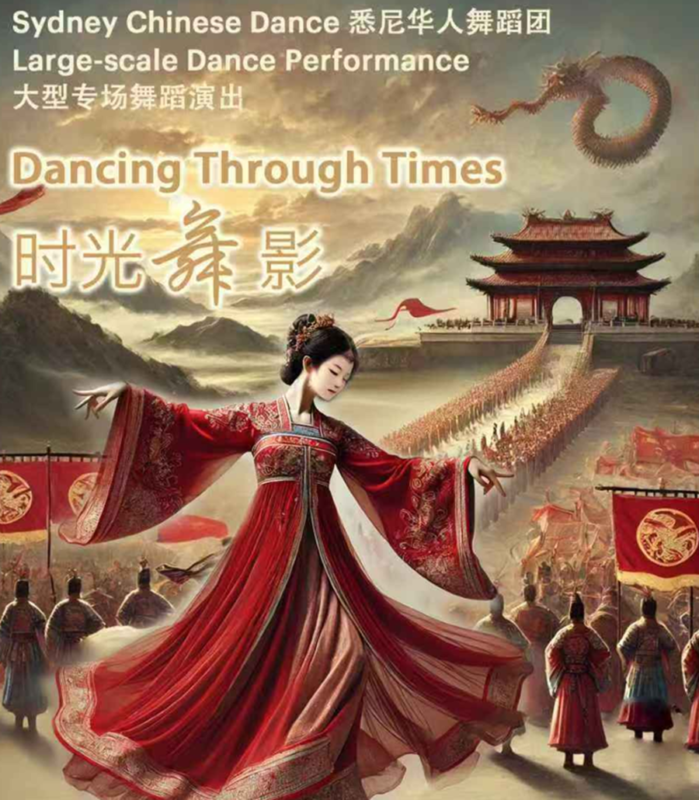On September 7, 2025, the Sydney Chinese Dance Group, in collaboration with the Hope Leukemia & Lymphoma Foundation presented the grand performance “Rhythms Through Times” in Sydney. This was not merely a dance show but an artistic journey across time and space, using dance to depict the flow of culture and the stage to illuminate the warmth of charity.
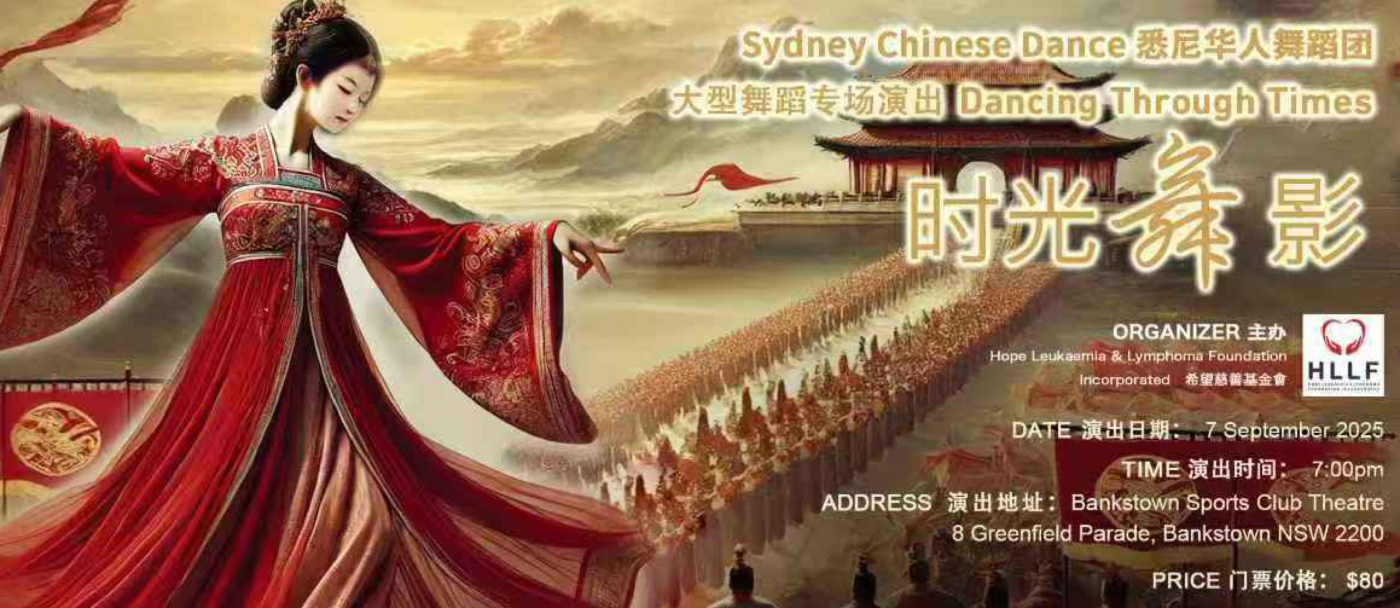
The evening was structured around the theme of “time,” divided into three chapters: “Fleeting Light,” “Ancient Rhymes,” and “Blossoming.” The dancers, with their grace, agility, and passion, brought to life the unique charm of Chinese dance, from traditional to contemporary. The opening piece, “Shanghai Bond,” recreated the distinctive ambiance of old Shanghai through dance, transporting the audience to an era of glamour, intrigue, and underlying turbulence.

The stage design was ingeniously crafted: neon signs, the melody of gramophones, retro cheongsams, and the illuminated Paramount Ballroom evoked the atmosphere of 1930s and 1940s Shanghai. Transitional actors vividly portrayed the daily lives of people in old Shanghai. The cheongsam dancers, with their poised postures and sharp movements, blended jazz rhythms with Chinese elements, showcasing the prosperity and turbulence of the bustling city. The Paramount dancers, dressed in CanCan-style costumes, vividly recreated the extravagance and luxury of Shanghai’s nightlife.

The most touching aspect of the performance was the portrayal of emotions through dance. The duet, through its physical language, conveyed the love between Xu Wenqiang and Feng Chengcheng, transcending family and fate. Xu Wenqiang’s character was resolute and passionate, with firm and powerful steps, while Feng Chengcheng was gentle and graceful, with fluid and delicate movements. Their moments of eye contact, hand-holding, separation, and reunion were filled with dramatic tension. Especially in the slow dance, their closeness and separation symbolized the intensity and helplessness of love, allowing the audience to feel the tragic undertones of their destinies.

This “Shanghai Bond” dance was not only an artistic reinterpretation of a classic film and television theme but also a cultural nostalgia. It sketched the zeitgeist of old Shanghai and, through the language of dance, interpreted the most moving emotional themes of that era—love and sacrifice.

In the end, the stage lights gradually dimmed, and the protagonists froze in a moment of separation, as if symbolizing an eternal memory. The audience, amidst applause, not only savored the beauty of the dance but was also deeply moved by the unforgettable love story.

” Lotus Fantasy Dance ” uniquely blended the romantic imagery of Western legend with the poetic symbolism of the East, presenting a cross-cultural artistic tapestry.

The dance opened with a blue-toned stage, where dancers moved with fluid grace like mermaids swaying in ocean waves. The white-clad fairies moved with rhythmic undulations, their bodies swaying like water ripples, conveying the freedom and mystery of the ocean. As the music transitioned, the stage colors shifted to elegant greens and pinks, slowly unfolding the imagery of lotus flowers. The dancers, holding leaves and flowers, moved with gentle grace, creating a sense of tranquility and purity—”emerging unstained from the mud.”

The most touching moment was when the imagery of mermaids and lotuses intertwined on stage. The dance transcended mere scene changes, becoming a cultural dialogue: Western romance met Eastern elegance, symbolizing the coexistence of innocence and resilience. The dancers’ physical language immersed the audience in both the fantasy of the deep sea and the poetry of the lotus pond. It was not just a dance but a lyrical poem on stage, using movement to interpret the blend of romance and steadfastness, fantasy and reality, leaving a lasting and beautiful artistic memory.

On the stage of “Rhythms Through Times,” ” Poetic Rhythm” offered the audience a novel artistic experience. The dance featured female dancers cross-dressing as four famous Tang Dynasty poets. Dressed in long robes with wide sleeves, holding folding fans, books, brushes, and paintings, they moved with ease and freedom, recreating the unrestrained spirit of Tang Dynasty literati through dance.

The dance began with the melodious sound of classical flutes. The dancers sometimes waved their sleeves and fans as if improvising poems; sometimes they raised their heads and sighed, as if expressing their emotions to the heavens. The female dancers, while cross-dressing, not only captured the demeanor of male poets but also added agility and elegance to the characters with their graceful movements. Strength and gentleness blended on stage, creating a unique tension.

The dance celebrated Tang poetry—a gem of Chinese culture—while infusing it with new energy through gender-bending artistry, the dance injected new vitality into classical imagery. The audience could sense the bold romanticism of the poets alongside the nuanced emotions conveyed by the female performers, making the piece a “poem within a dance.”

“Poetic Charm” was not just a dance but an artistic expression transcending gender and era, allowing classical and modern to dialogue on stage. With its light movements and profound poetry, it earned enthusiastic applause from the audience.

Next, “Ink Dance” was a piece deeply rooted in Eastern aesthetic world. The dancers used their bodies as brushes and the stage as rice paper, transforming the charm of Chinese calligraphy into the beauty of dance. On stage, ink-wash lighting and backgrounds created a scroll-like atmosphere. The dancers, dressed in elegant costumes, moved with flying sleeves, resembling the sweeping strokes of a brush, full of vitality. The choreography cleverly blended strength and grace: turns, sleeve flicks, and leaps were like brushstrokes sketching lines on paper, while slow stretch movements resembled ink spreading on rice paper. The formation changes of the group dance were like the layout of calligraphy, and the solo dances were like poetic highlights. While appreciating the dance, the audience could almost feel the “qi, rhythm, meaning, and spirit” of calligraphy art.

“Ink Dance” was not only a visual delight but also a cultural transmission. It fused dance and calligraphy, two Eastern arts, using dynamic body language to interpret the spirit of static ink, allowing the audience to experience the unique charm of Chinese culture—”words convey truth, dance conveys emotion.” This dance wandered between poetry and philosophy, like a living ink-wash painting, leaving a profound artistic aftertaste.

Director Yuan Jing’s Peacock Dance was a highlight of the evening. With exquisite grace and precision, she embodied the elegance and vitality of a peacock—from the shimmering “fanning” of feathers to delicate drinking and preening movements. The dance began with “peacock spreading its tail,” the dancer’s arms stretching out, fingertips trembling delicately, as if peacock feathers shimmered in the sunlight. As the music rose and fell, the dancer sometimes stepped lightly, sometimes spun with flowing sleeves, portraying the peacock drinking water, preening, and playing. The movements were soft yet powerful, full of vitality and agility.
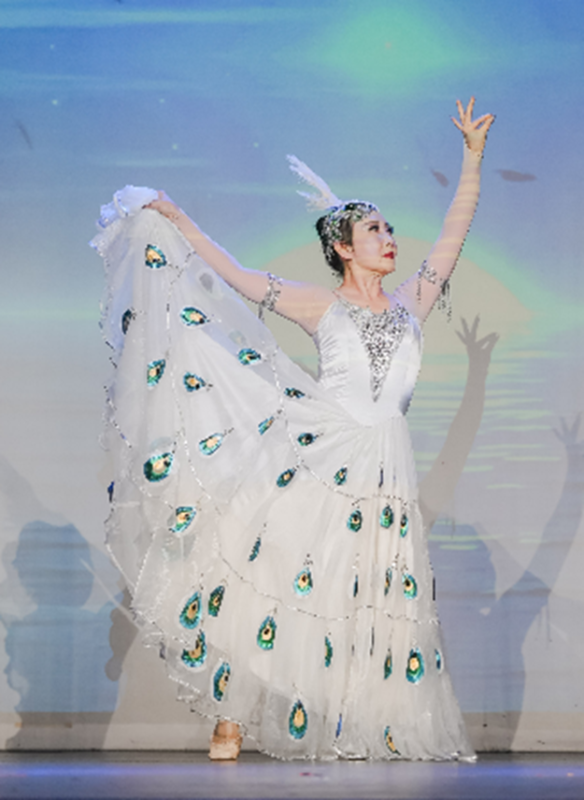
The beauty of the “Peacock Dance” lay not only in the reproduction of form but also in the conveyance of artistic conception. In Dai culture, the peacock symbolizes propitious, beauty, and kindness. The dancers transmitted this ethnic spirit to the audience through their performance. The composure, purity, and spirituality on stage provided an aesthetic enjoyment beyond the dance itself. The “Peacock Dance” was a blend of natural beauty and humanistic beauty, allowing the audience to feel the harmony between humans and nature and the vitality of life while appreciating the dance.
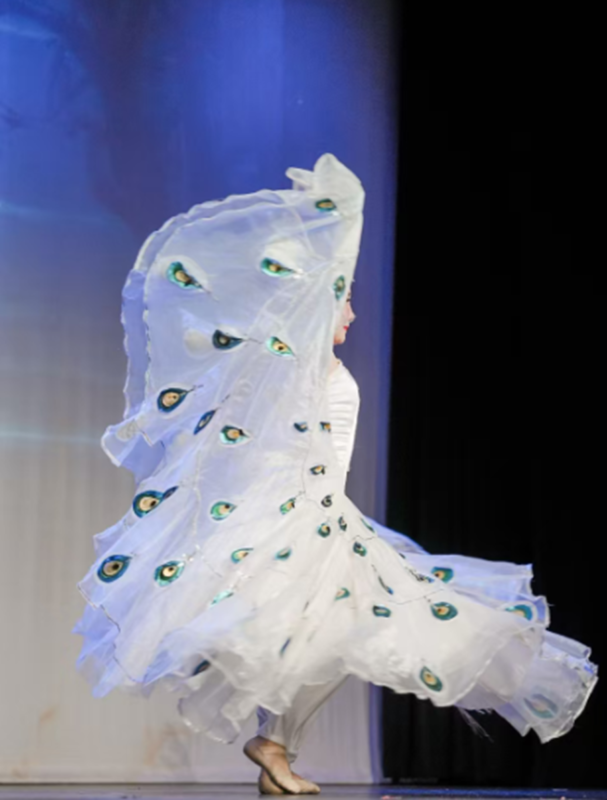
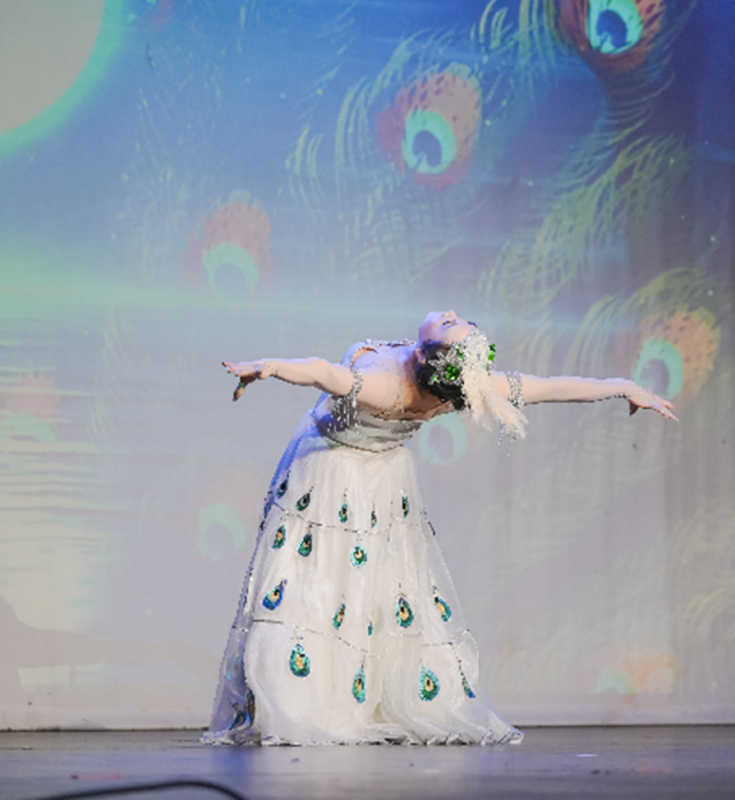
Finally, “The Four Great Beauties” presented the legendary images of Xi Shi, Wang Zhaojun, Diao Chan, and Yang Guifei through a combination of group and solo dances. The dance not only recreated their peerless elegance but also depicted different historical contexts and personalities through movements, costumes, and music.

Xi Shi · The Beauty Who Captivated the Fish **
The dancer, dressed elegantly, performed a water sleeve dance to depict the scene of “Washing Silk.” Her light steps and tender expression conveyed Xi Shi’s gentle and delicate demeanor. The dance, set to soothing music, revealed her inner conflict: both a beauty and a symbol of national sacrifice.
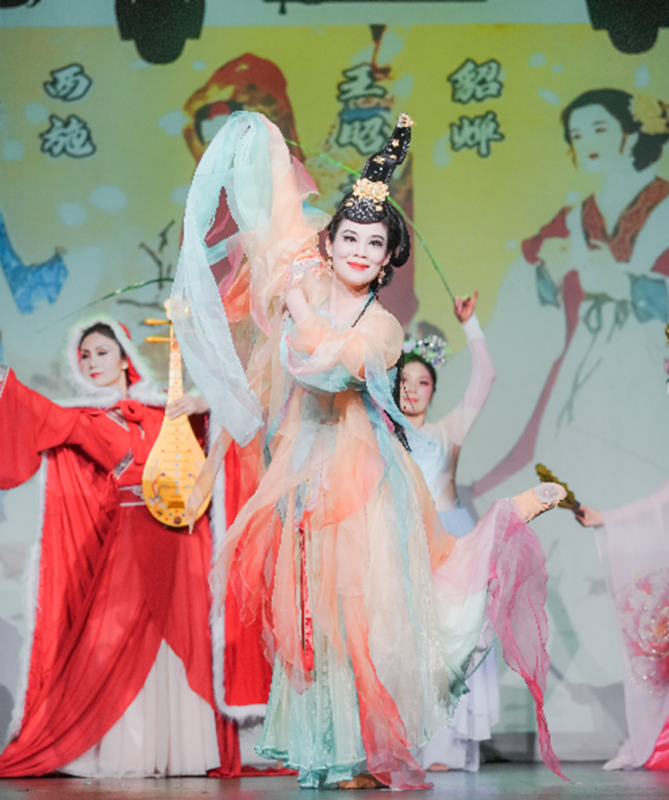

Wang Zhaojun · The Beauty Who Startled the Swan
The dancer, draped in fur and carrying a pipa, performed against the backdrop of robust Hujia (an ancient Central Asian reed instrument) and distant horse-head fiddle music, expressing her boldness and sorrow as she left for a political marriage. Her movements were broad and firm, conveying her courage to sacrifice herself for peace. Her lone figure on stage was deeply moving.
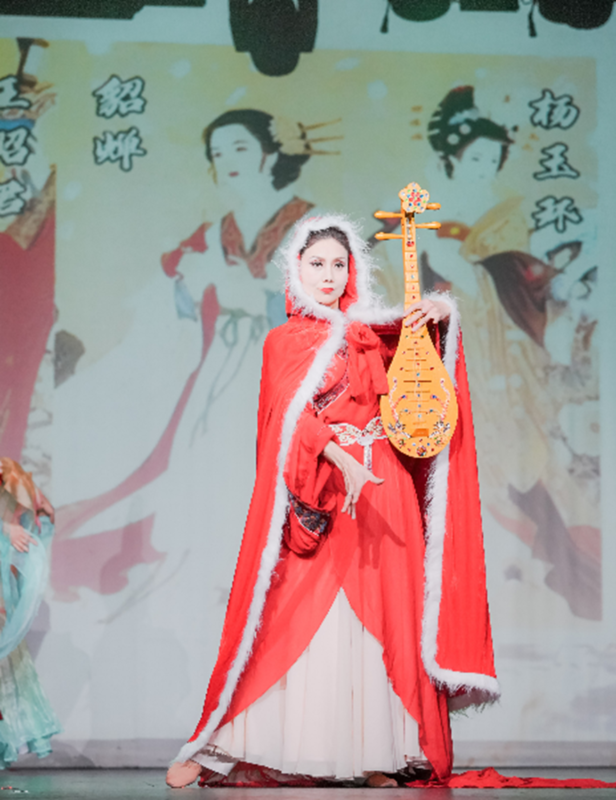

Diao Chan · The Beauty Who Dazzled the Moon
The dancer, with her slender figure and graceful turns, displayed Diao Chan’s intelligence and beauty. Her interactions with “Lü Bu” and “Dong Zhuo” were filled with tenderness and strategy, creating strong stage tension. Behind the exquisite and graceful movements were entwined schemes and destiny.
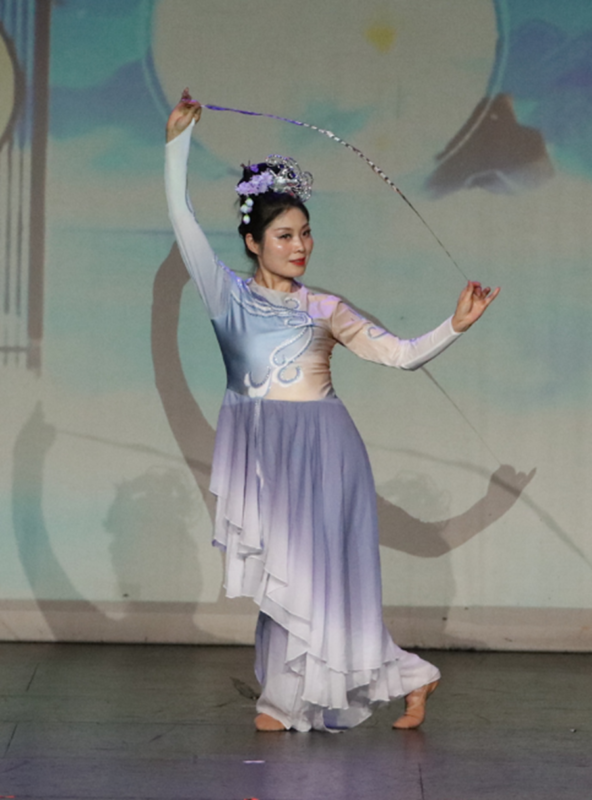

Yang Guifei · The Beauty Who Shamed the Flowers
The dancer, in magnificent attire, performed to Tang music. As the melody of “Song of the Rainbow Skirt and Feathered Robe” played, her movements were expansive, elegant, and magnificent, showcasing the splendor of the Tang court and transporting the audience to the prosperous Chang’an of a thousand years ago. At the climax, her steps gradually slowed, her eyes revealing the helplessness of love and the tragedy of destiny.
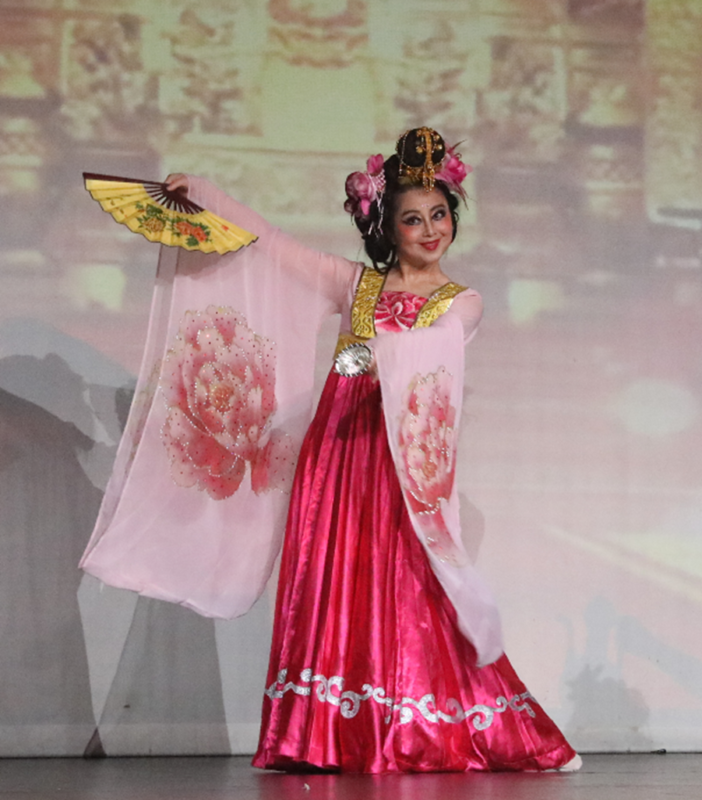

The entire dance, through the alternating appearances of these four historical figures, created contrast and resonance. Xi Shi’s gentleness, Wang Zhaojun’s tragedy, Diao Chan’s cleverness, and Yang Guifei’s magnificence together formed a long scroll of ancient women’s destinies. The stage lighting and music enhanced this atmosphere, allowing the audience to feel the weight of history and the sorrow of life while enjoying the beauty.

The stage design of “Rhythms Through Times” was also thoughtfully crafted. The flowing lights seemed to guide the audience through time, and the changing backgrounds integrated seamlessly with the dance themes. Tradition and modernity, East and West converged here, immersing the audience not only in a visual feast but also in the blending and extension of cultures.

It is worth mentioning that all proceeds from this performance were donated to the “Hope Leukemia & Lymphoma Foundation” to support disadvantaged groups. The combination of art and charity gave the performance deeper significance. Every spin and leap of the dancers seemed to convey warmth and kindness, touching the entire audience.

Overall, “Rhythms Through Times” was a successful performance that combined artistic excellence with a spirit of public welfare. It not only demonstrated the professional strength and cultural depth of the Sydney Chinese Dance Ensemble but also allowed the audience to experience the power of love and hope through the beauty of art.
